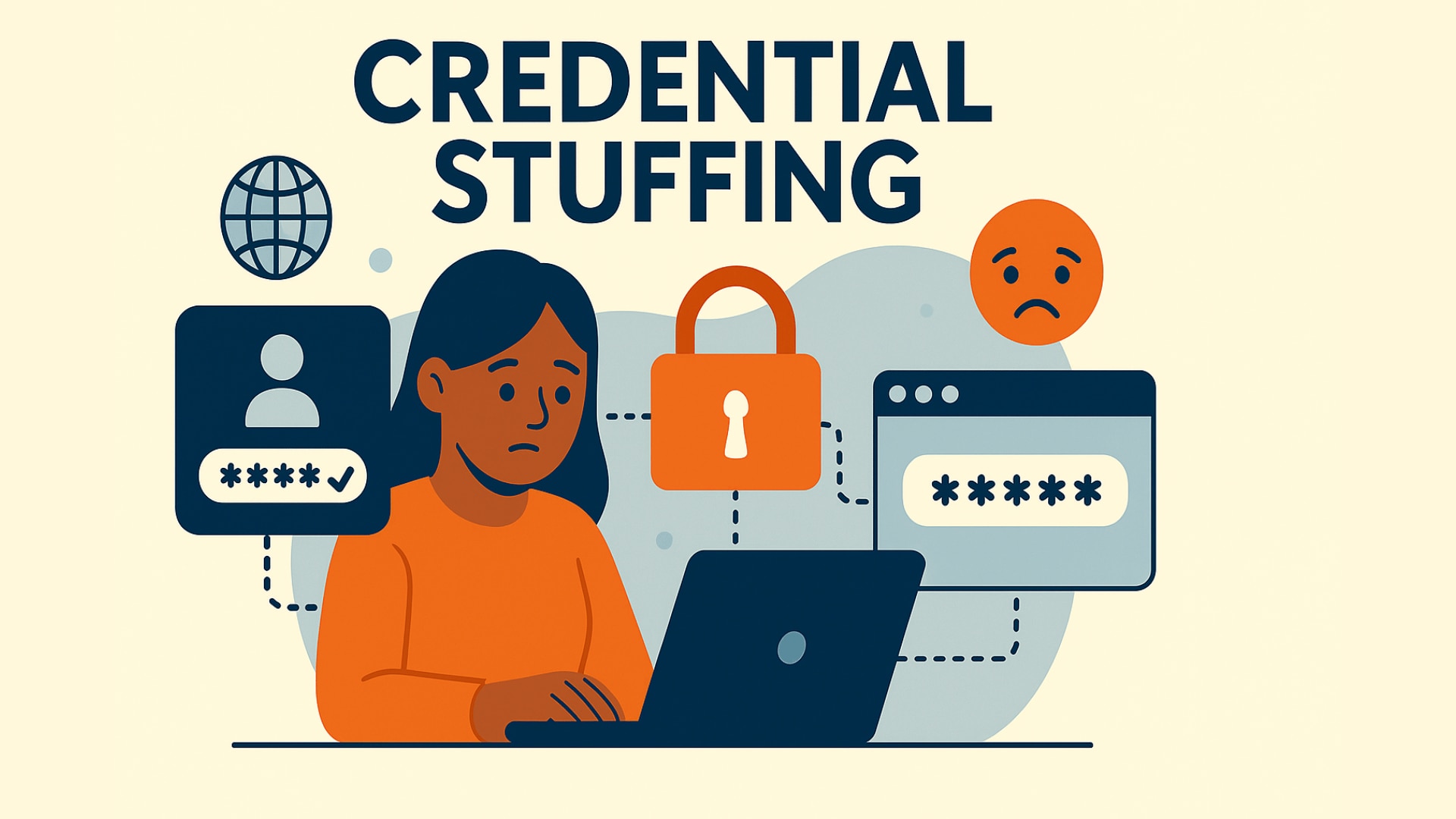
As businesses continue to rely on digital platforms, securing your online presence becomes more important than ever. One common and dangerous attack method businesses face today is Credential Stuffing. While the term may sound technical, understanding this attack and how to defend against it is essential for anyone managing a website or online service.
Table of contents
What Is Credential Stuffing?
Credential Stuffing is a type of cyberattack where criminals use stolen usernames and passwords to try to access various online accounts. These stolen credentials typically come from past data breaches or phishing attacks. Attackers use automated tools, or bots, to test these stolen login combinations across multiple websites, hoping to find accounts where users have reused the same credentials.
Think of it like a burglar with a bunch of keys, trying each one on different doors. If the key fits, they gain access. Attackers do the same with stolen credentials, trying to break into accounts across many sites.
Unlike traditional brute-force attacks, which attempt to guess passwords, Credential Stuffing uses real login credentials that have already been compromised. This makes it more effective and harder to block.
Why Is Credential Stuffing So Effective?
Credential Stuffing works because many people reuse the same passwords across multiple websites. Studies show that nearly 85% of users use identical credentials on more than one platform. So, when attackers obtain stolen login details from one breach, they can test them on dozens or even hundreds of other websites.
Attackers also use sophisticated bots to automate the process. These bots can attempt thousands or even millions of login combinations in a very short time. Bots can even mask their behavior to look like normal user activity. As a result, it’s tough for websites to tell if login attempts are legitimate or part of an attack.
Credential Stuffing is particularly dangerous for businesses. A successful attack can lead to Account Takeovers (ATO), where attackers take control of user accounts. They might steal sensitive data, make fraudulent purchases, or use the account to send spam or phishing emails. The stolen credentials can also be sold on the dark web, causing further damage.
Risks of Credential Stuffing: Identity Theft, Financial Loss and More
Credential Stuffing isn’t just about hackers gaining access to user accounts. The consequences of these attacks are far-reaching and can have significant financial, legal, and reputational impacts on businesses and their users. Let’s take a closer look at some of the most serious risks associated with Credential Stuffing.
1. Identity Theft
One of the primary threats posed by Credential Stuffing is identity theft. When attackers successfully take over user accounts, they often gain access to highly sensitive personal information, including names, addresses, phone numbers, and, in many cases, social security numbers or government identification numbers. This data is invaluable to cybercriminals and can be used for a range of fraudulent activities.
For example, attackers might use stolen identity information to apply for loans, open credit cards, or make large purchases. This leaves the user exposed to financial loss and can cause significant emotional distress as they work to reclaim their identity.
Moreover, once attackers have successfully compromised an account, they might use it to launch more targeted attacks, including social engineering tactics. By leveraging personal data, they can deceive other victims into divulging further information, leading to a broader attack chain.
2. Financial Loss for Users
The immediate financial threat to users is obvious: attackers often steal money directly from compromised accounts. For example, they may use stolen credentials to make unauthorized purchases, transfer funds, or drain balances from digital wallets or e-commerce accounts. Even small transactions can accumulate, especially when several accounts are attacked.
For businesses, chargebacks from users who experience fraud or unauthorized transactions can be costly. In addition, if a website holds financial data or offers paid services, a successful Credential Stuffing attack can lead to a significant loss of funds. This loss isn’t limited to direct theft; companies may also face compensation claims from users who have been financially harmed.
3. Business Revenue and Reputation Damage
When Credential Stuffing attacks succeed, businesses often bear the brunt of the consequences. As the attack unfolds, affected customers may abandon the site or service, causing a dip in user trust and revenue. The loss of consumer confidence can result in long-term damage to your brand and reputation, which is often far more difficult to recover from than the immediate financial losses.
If a business’s website is repeatedly targeted, it may face regulatory scrutiny, especially if the attack results in a breach of sensitive personal data. Regulations like GDPR (General Data Protection Regulation) and CCPA (California Consumer Privacy Act) require businesses to notify users about data breaches. Failing to do so promptly can lead to hefty fines, further legal action, and loss of business.
4. Loss of Sensitive Data
In addition to personal identity information, Credential Stuffing can lead to the compromise of other sensitive data, such as credit card numbers, bank account details, and login credentials for other platforms. Cybercriminals often use these details to access financial institutions, make fraudulent transfers, or buy expensive goods on a victim’s behalf.
Moreover, for businesses that store or handle large volumes of customer data, a successful attack could mean exposing private information to the public or to criminals. This could open the door to data resale on the dark web, where hackers sell stolen information to other malicious actors.
5. Increased Cybercrime and Dark Web Exploits
Once a hacker has obtained a validated batch of credentials from a successful Credential Stuffing attack, the next step is often to sell those credentials on the dark web. These stolen credentials can be sold in bulk, giving criminals access to an even wider pool of potential victims.
As attackers share and sell validated credentials, it can perpetuate a cycle of cybercrime. Criminal organizations can use these stolen credentials to conduct further attacks across other platforms, making it harder for victims to track and stop fraudulent activities. Over time, this becomes an industry in itself, feeding on the compromised data and perpetuating further financial damage for both businesses and consumers.
6. Legal and Regulatory Consequences
From a legal standpoint, businesses face regulatory consequences when users’ personal information is compromised through an attack like Credential Stuffing. Laws such as GDPR and CCPA hold companies responsible for securing personal data. If a breach occurs, organizations must comply with strict reporting timelines and transparency requirements.
Failure to protect sensitive user data can lead to significant fines. For example, GDPR fines can be as high as €20 million or 4 percent of a company’s global turnover, whichever is higher. In addition to direct financial penalties, companies may face lawsuits from affected individuals or organizations, increasing the financial burden and potential reputational damage.
Preventing Credential Stuffing
To defend against Credential Stuffing, it’s crucial to adopt a multi-layered security strategy. A combination of user education and technical defenses can significantly reduce your risk.
1. Implement Multi-Factor Authentication (MFA)
Multi-Factor Authentication (MFA) is one of the most effective ways to secure accounts. MFA adds a second layer of verification, such as a code sent to the user’s phone or a biometric scan. Even if attackers steal a password, they still need the second factor to access the account.
2. Use Anti-Bot Technology
Anti-bot solutions are crucial for blocking automated attacks like Credential Stuffing. These technologies analyze user behavior, monitor traffic patterns, and identify bots. By detecting and blocking bots before they can attempt login, these solutions stop attacks before they start.
3. Monitor Login Attempts and Traffic
By regularly monitoring login attempts, you can identify suspicious behavior early. Look for signs like failed login attempts, frequent requests from the same IP addresses, or logins from unusual locations. Tools that cross-check user credentials with known data breaches can help you flag compromised accounts before attackers can exploit them.
4. Leverage CAPTCHA to Block Bots
CAPTCHA systems challenge users to prove they are human. While some sophisticated bots can bypass CAPTCHA, it still serves as an important barrier against automated attacks. Using CAPTCHA alongside other defenses, like MFA and anti-bot tools, adds an extra layer of protection.
At captcha.eu, we offer GDPR-compliant, user-friendly CAPTCHA solutions that help block bots and prevent fraudulent login attempts. However, it’s essential to combine CAPTCHA with other security measures for maximum effectiveness.
5. Educate Your Users on Strong Password Practices
User education is vital. Encourage your users to avoid password reuse and choose strong, unique passwords for each account. Password managers can help users store complex passwords securely. While businesses can’t directly control user behavior, providing resources to educate users on best practices reduces the risk of Credential Stuffing.
Role of CAPTCHA in Credential Stuffing
CAPTCHA is a useful tool for defending against bots, but it’s not a one-size-fits-all solution. While CAPTCHA challenges are effective at stopping many bots, some advanced ones can bypass these systems by using machine learning or other techniques. As technology evolves, attackers are finding new ways to get around basic CAPTCHA systems.
Nevertheless, CAPTCHA should be part of a broader security strategy. Advanced CAPTCHA solutions, like invisible CAPTCHA and behavioral CAPTCHA, offer stronger protection. These systems analyze how users interact with your website to identify suspicious behavior, making it harder for bots to mimic human actions.
When combined with other measures like multi-factor authentication (MFA) and anti-bot systems, CAPTCHA can significantly reduce your risk of automated attacks. Think of it as an important tool in a layered defense approach.
The Future of Credential Stuffing: How Attacks Are Evolving
The landscape of Credential Stuffing attacks is changing. Attackers are increasingly using artificial intelligence (AI) and machine learning to enhance their bots. These technologies allow bots to mimic human behavior more closely, making it harder for websites to distinguish between legitimate users and attackers.
AI-powered bots can also adapt to defenses like CAPTCHA. They can learn from previous attempts and modify their behavior to bypass security measures. As bots become smarter, it’s crucial for businesses to stay ahead of the curve by updating their security protocols regularly.
To protect against these evolving threats, businesses need to implement next-generation bot management systems and AI-based detection tools. These solutions will be essential in the future to block increasingly sophisticated Credential Stuffing attacks.
Conclusion
Credential Stuffing is a serious and growing threat to businesses. If left unchecked, it can lead to account takeovers, data breaches, and financial loss. Fortunately, there are several steps you can take to defend your business and users. Implement multi-factor authentication (MFA), use anti-bot technologies, monitor login attempts, and leverage CAPTCHA to block automated attacks. Educating your users on good password practices is also essential in reducing the impact of Credential Stuffing.
While no solution offers 100% protection, adopting a multi-layered approach can greatly reduce your risk. If you’re looking for an effective CAPTCHA solution, captcha.eu provides privacy-compliant tools to help protect your website from bot-driven attacks.
Stay vigilant, update your security practices regularly, and you’ll be better equipped to fend off Credential Stuffing attacks and protect both your users and your business.
100 free requests
You have the opportunity to test and try our product with 100 free requests.
If you have any questions
Contact us
Our support team is available to assist you.




